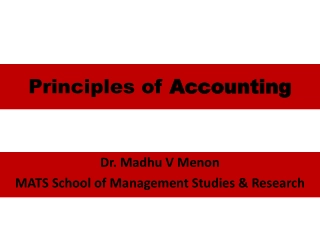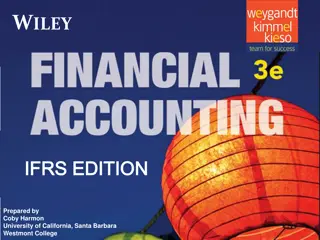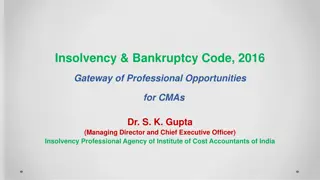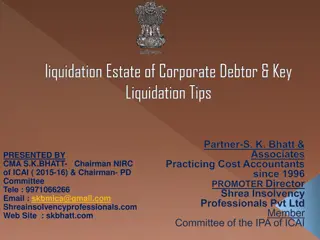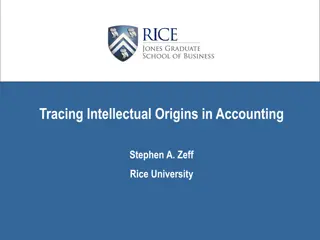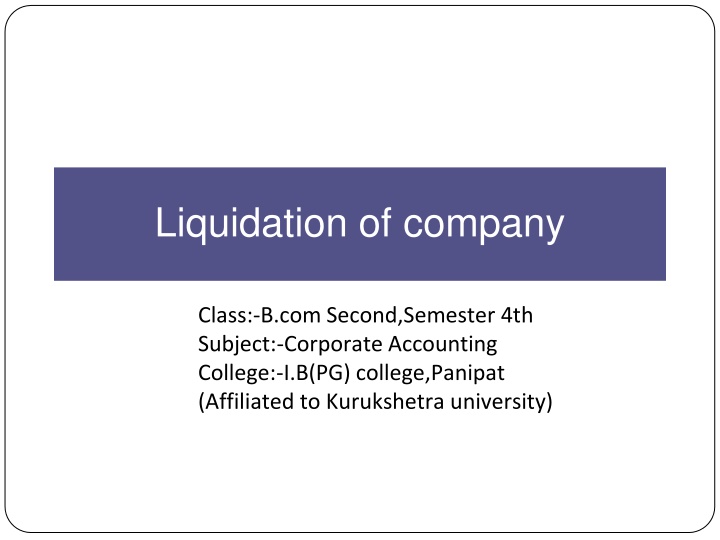
Company Liquidation Process in Corporate Accounting
Explore the process of liquidation in corporate accounting, covering compulsory and voluntary modes, the role of a liquidator, distribution of assets, and winding up leading to dissolution as defined in the Companies Act 2013.
Download Presentation

Please find below an Image/Link to download the presentation.
The content on the website is provided AS IS for your information and personal use only. It may not be sold, licensed, or shared on other websites without obtaining consent from the author. If you encounter any issues during the download, it is possible that the publisher has removed the file from their server.
You are allowed to download the files provided on this website for personal or commercial use, subject to the condition that they are used lawfully. All files are the property of their respective owners.
The content on the website is provided AS IS for your information and personal use only. It may not be sold, licensed, or shared on other websites without obtaining consent from the author.
E N D
Presentation Transcript
Liquidation of company Class:-B.com Second,Semester 4th Subject:-Corporate Accounting College:-I.B(PG) college,Panipat (Affiliated to Kurukshetra university)
LIQUIDATION Liquidation or winding up is a Legal term and refers to the procedure through which the affairs of the company are wound up by law.
Winding up of a company has been defined in the Companies Act 2013 as the process whereby its life is ended and its property is administered for the benefit of its creditors & members. An Administrator called the Liquidator is appointed and he takes control of the company, collects its assets , pays its debts & finally distributes any surplus among the members in accordance with their rights.
MODES OF LIQUIDATION MODES OF LIQUIDATION Compulsory Liquidation Voluntary Liquidation
companies act provides that a company can be liquidated in any of the following ways : COMPULSORY WINDING UP BY THE COURT VOLUNTARY WINDING UP BY THE MEMBERS Generally the provisions of the Act with respect to the winding up apply to winding up of a company whether it be by the court or voluntary or subject to the supervision of the court.
Liquidator of the company will prepare a list of contributories who be made liable to contribute to the assets of the company in case assets are not sufficient to meet the claims of various claimants . In case there is a surplus in the assets, the liquidator of the company will prepare a list of those members, who are entitled to share this surplus. Liquidator of the company will collect & realise its assets & distribute the proceeds among right claimants as per the procedure of the law. Winding up ultimately leads to dissolution of the company. The companies life will come to an end & it will be no more an artificial person in
PAYMENT The amount received from the assets not specifically pledged & the amounts contributed by the contributories must be distributed by the liquidator in the following order: Expenses of winding up including the liquidators remuneration Creditors secured by the floating charge on the assets of the company Preferential creditors Unsecured creditors The surplus, if any, amongst the contributories (i.e.
SHAREHOLDERS Preference shareholders get the priority over the equity shareholders as regards the payment of their capital & the dividend payable upto the ate of winding up. The holders of cumulative preference shares are entitled to arrears of dividend if there is a surplus after the return of the amount of the equity shareholders or if the Articles state that arrears of preference dividend are to be paid before anything is paid to equity shareholders. EQUITY SHAREHOLDERS Any surplus left after making payment to preference shareholders is distributed among the equity shareholders if all the shares are equally paid up. But if the shares are called in unequal proportions, the liquidator should see that the capital contribution by the shareholders should be the same.
PREFERENTIAL CREDITORS the following creditors are treated as preferential creditors: all revenues, taxes, cesses & rates payable to the government or local authority will be treated as preferential creditors provided that it must become due within 12 months before the date of winding up. 4 months salary & wages due to the employees of the company will be treated as preferential provided that it must become due within 12 months before the date of winding up. Maximum of Rs. 20000 will be treated as preferential creditors. All accrued holiday remuneration payable to an employee due to termination of his employment is
The person who advances money for making the payment under (ii) & (iii) mentioned above will be treated as preferential. Any sum payable by the company under the Employees State Insurance Act, 1948 will be treated as preferential provided that it must become due within 12 months before the date of winding up. Compensation payable by the company under Workmen Compensation Act, 1923 is treated as preferential. Any sum payable by the company to its employees from a Providend Fund, Pension Fund, Gratuity Fund or any other fund maintained foe the
LIQUIDQTORS FINAL STATEMENT OF ACCOUNTS The main job of the liquidator is to collect the assets of the company & realise them & distribute the money realised among right claimants. For this purpose he maintains a cash book for recording the receipts & payments & is required to submit an abstract of the cash book to the court in case of compulsory winding up & to the company in case of voluntary winding up. The liquidator is also required to prepare an account known as the Liquidator s Final Statement of accounts after the affairs of the company are fully wound up.
LIQIDATORS FINAL STATEMENT OF ACCOUNT Receipts Amount (Rs.) To Assets Realised :- -- Cash at Bank -- Cash in Hand -- Marketable Securities -- Bills Receivable -- Trade Debtors -- Stock in trade -- Freehold property -- Plant and Machinery -- Furniture and Fittings To Surplus fromSecurities held by Secured Creditors To Proceeds of calls made Payments Amoun t (Rs.) By Legal Charges By Liquidator Remuneration By Liquidation Expenses By Debenture -holders (having a floating charge on the assets of the co.) By Preferential Creditors By Unsecured Creditors By Preference Shareholders By Equity Shareholders

